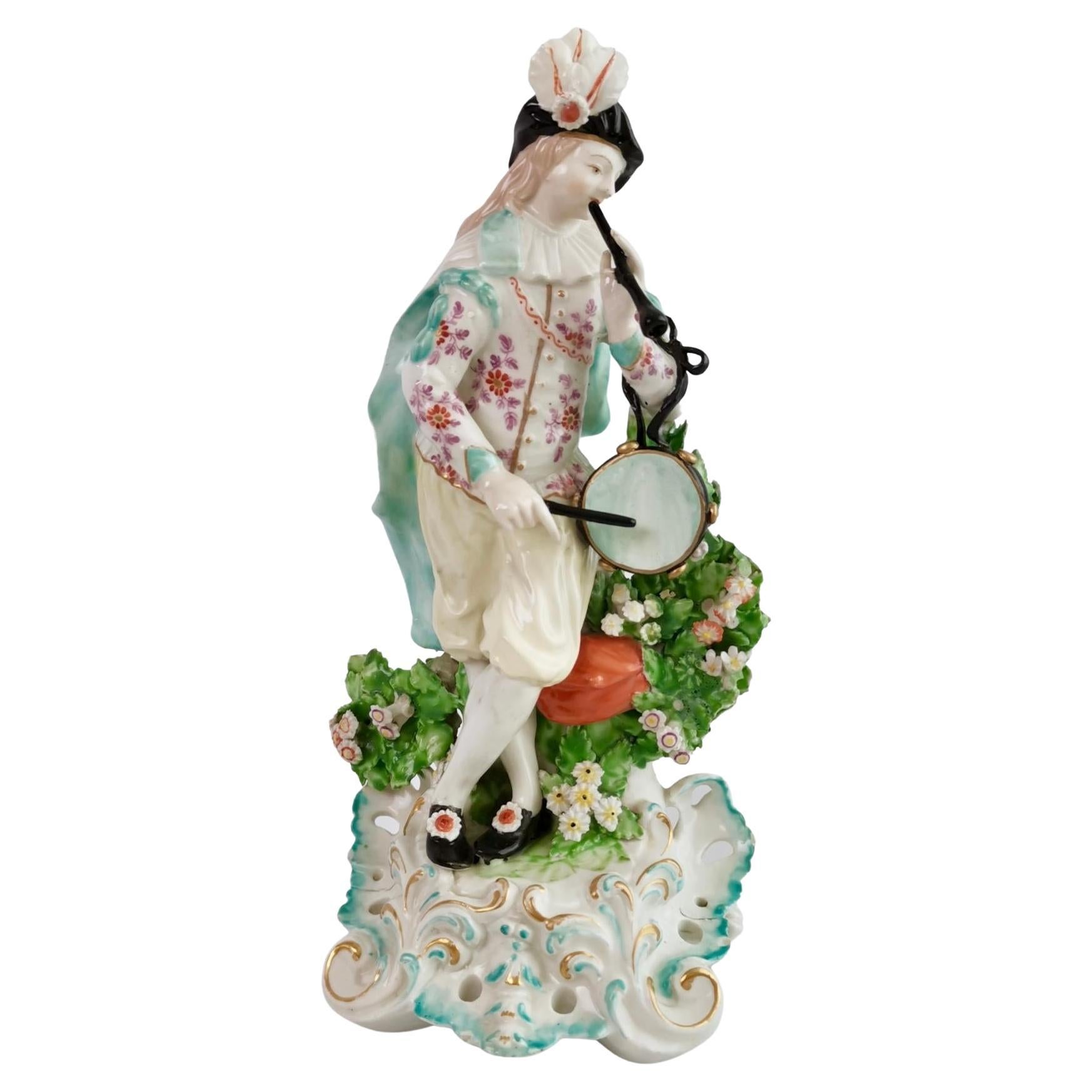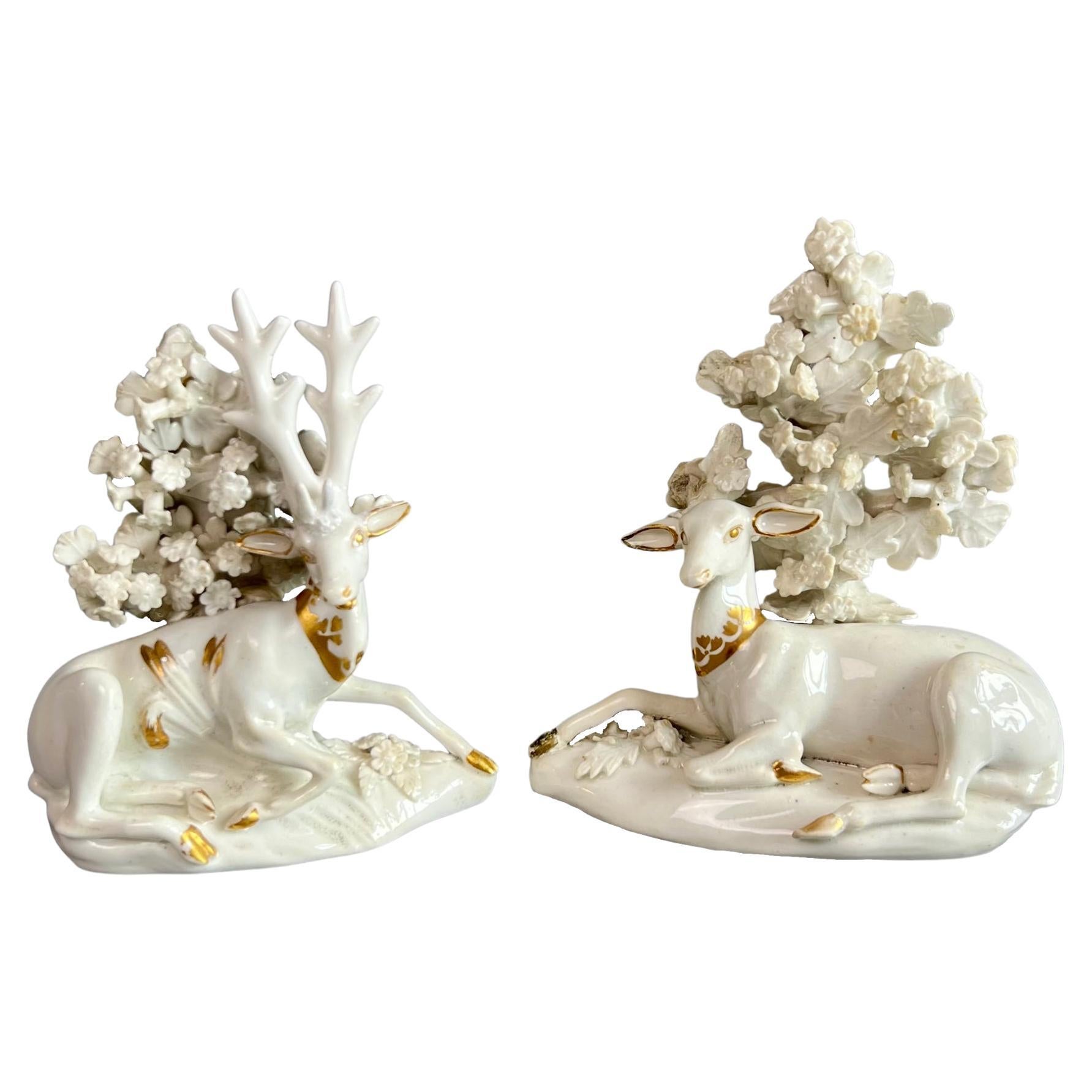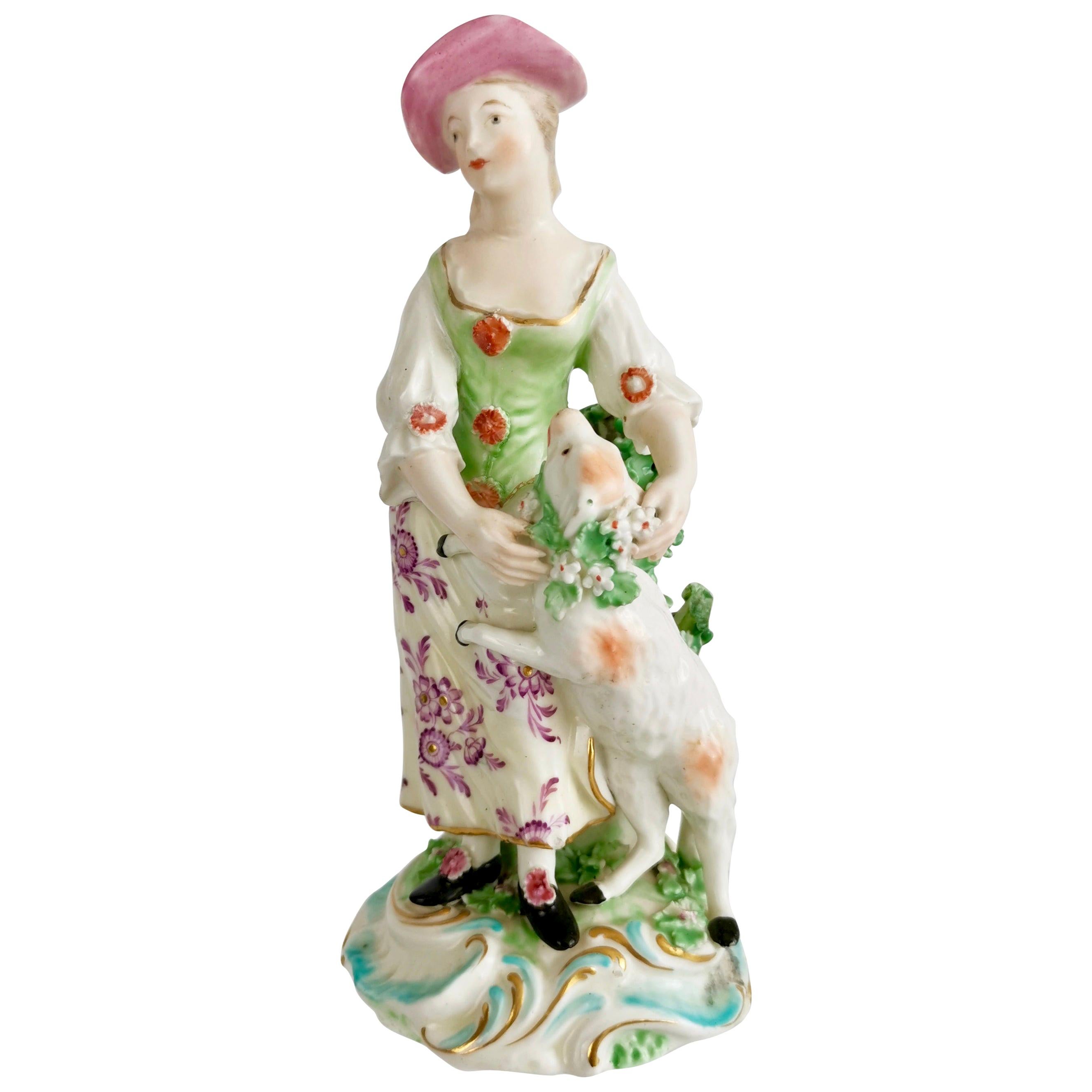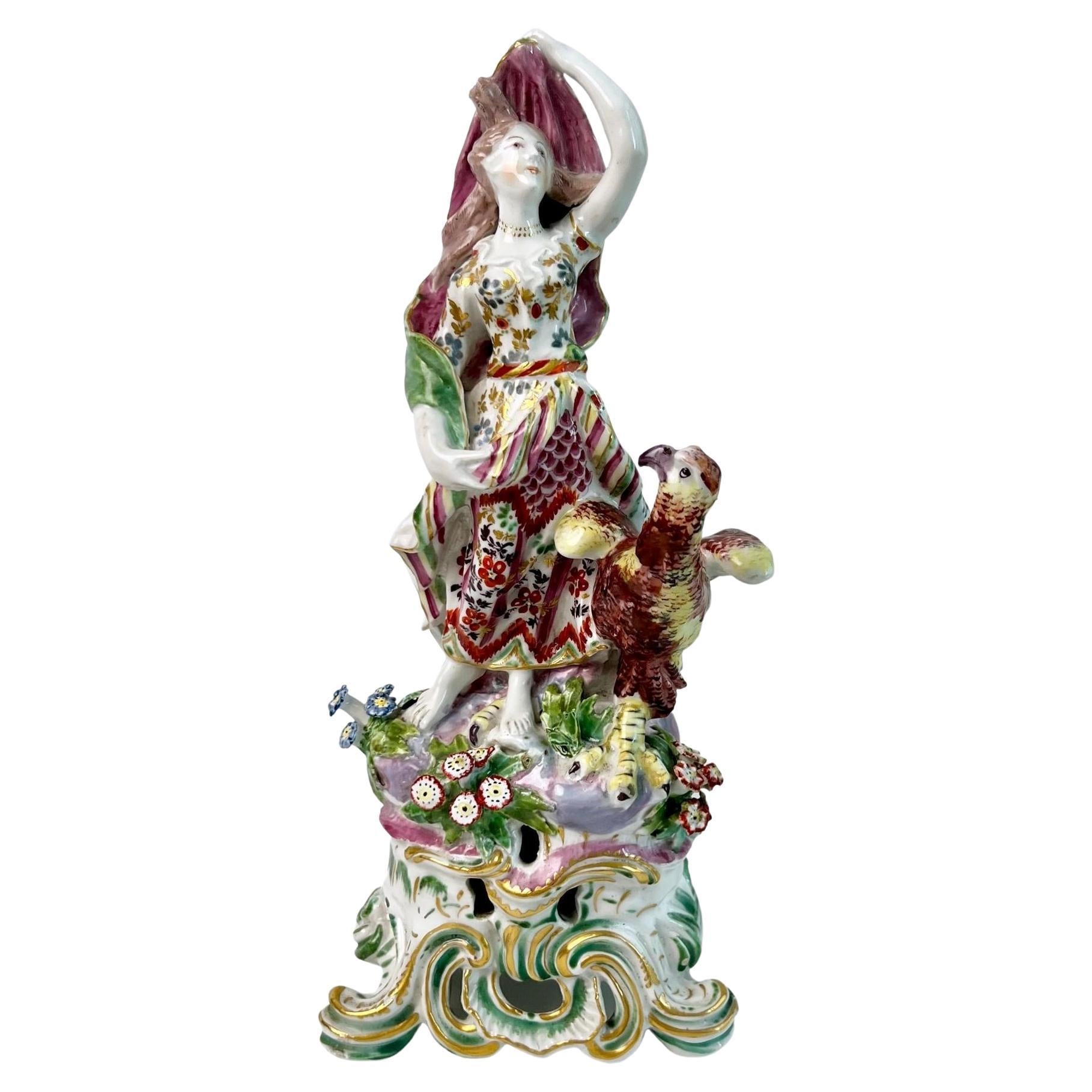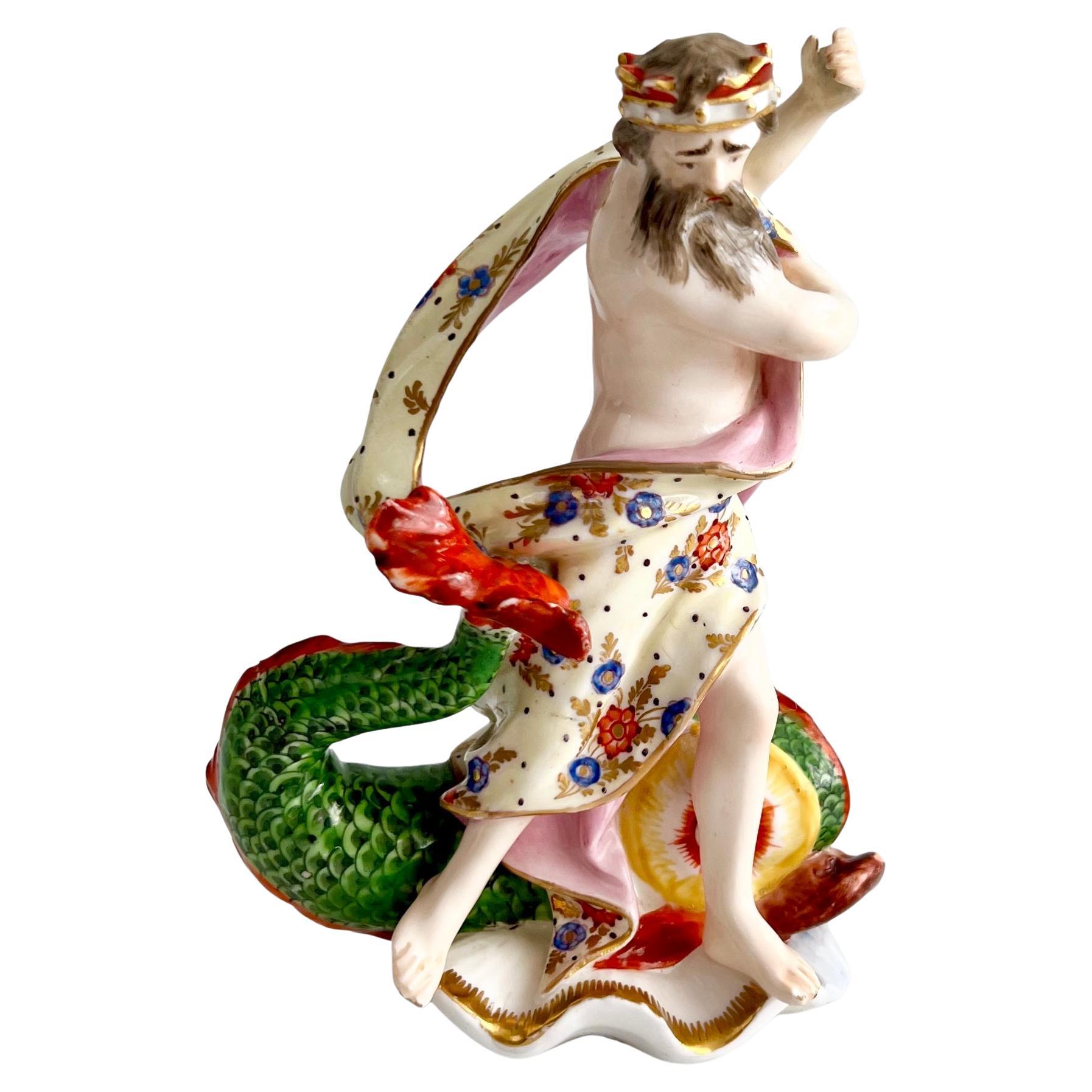Items Similar to Derby Pair of Candle Stick Figures, Bagpiper and Lady with Lute, Rococo, Ca 1765
Want more images or videos?
Request additional images or videos from the seller
1 of 21
Derby Pair of Candle Stick Figures, Bagpiper and Lady with Lute, Rococo, Ca 1765
About the Item
This is a beautiful pair of Derby porcelain candlestick figures of a bagpiper and a lady with lute, made between 1759 and 1769, which was the Rococo era. The pair is one of Derby's famous figure pairs and this particular pair is very beautifully made.
The Derby Porcelain factory has its roots in the late 1740s, when Andrew Planché, a Walloon Huguenot refugee, started making simple porcelain toys shaped like animals in his back yard. In 1756 Staffordshire enameller William Duysbury and banker John Heath started a new porcelain factory with Planché and this was to grow out to the largest factory of its time, buying up the bankrupted Chelsea and Bow factories, as well as the stock of several other workshops including that of James Giles. The combination of various traditions, porcelain making skills and sophisticated clients enabled Duesbury to create one of the best porcelain factories of the 18th and 19th Centuries, which after many ups and downs is still operative today.
This pair of figures is famous and it was shaped after a source that has not been identified.
You see a lady with a lute and a lamb by her side, and a gentleman with bagpipes and a dog by his side. Both are beautifully dressed in Rococo outfits; the gentleman in particular has a stunning waist coat and the lady in a skirt with very interesting patterns. The animals have adorable expressions on their faces and the lady and gentleman look sophisticated and delicate, with slightly blushing cheeks. Both figures have waste-high bocage behind them. They have swan-neck candle sconce holders that have been fitted with Meissen-type sconces at a later date. The colours of these figures are fresh and delicate.
These figures were used to adorn the dinner table when dessert was served; groups of figures could serve to express something about the host, the guests, or to direct the conversation. There were many series with particular themes, such as pastoral types and animals, musicians, the trades, Greek and Roman mythology and the Elements, Seasons or Virtues.
The figures are unmarked but they do have the typical patch marks of that period.
CONDITION REPORT: The figures are in good condition with some light repairs. The repairs have been done professionally, however they are dated and therefore have slightly discoloured. Both figures have one rococo-scroll of the base replaced; the sconces are later replacements in the Meissen style; and there are several small replacements such as the lamb's ear and the top of the lute. The lady has a fine crack running through the back of her base, and a small crack through one of her feet - she might have been broken and placed back together, but these cracks do not stand out.
If desired we'd be happy to arrange for the repairs to be redone with modern materials that will not discolour, however due to the current lack of restorers this might take a significant amount of time to be finished.
Antique British porcelain is never perfect. Kilns were fired on coal in the 1800s, and this meant that china from that period can have some firing specks from flying particles. British makers were also known for their experimentation, and sometimes this resulted in technically imperfect results. Due to the shrinkage in the kiln, items can have small firing lines or develop crazing over time, which should not be seen as damage but as an imperfection of the maker's recipes, probably unknown at the time of making. Items have often been used for many years and can have normal signs of wear, and gilt can have signs of slight disintegration even if never handled. I will reflect any damage, repairs, obvious stress marks, crazing or heavy wear in the item description but some minor scratches, nicks, stains and gilt disintegration can be normal for vintage items and need to be taken into account.
There is widespread confusion on the internet about the difference between chips and nicks, or hairlines and cracks. I will reflect any damage as truthfully as I can, i.e. a nick is a tiny bit of damage smaller than 1mm and a chip is something you can easily see with the eye; a glazing line is a break in the glazing only; hairline is extremely tight and/or superficial and not picked up by the finger; and a crack is obvious both to the eye and the finger.
DIMENSIONS: Height ca 22cm (8.6").
- Creator:Derby (Maker)
- Dimensions:Height: 1 in (2.54 cm)Width: 1 in (2.54 cm)Depth: 1 in (2.54 cm)
- Sold As:Set of 2
- Style:Rococo (Of the Period)
- Materials and Techniques:
- Place of Origin:
- Period:1760-1769
- Date of Manufacture:circa 1765
- Condition:Repaired: Some small professional repairs, see description. Wear consistent with age and use. Minor losses. In excellent antique condition with some small professional repairs as visible in the pictures.
- Seller Location:London, GB
- Reference Number:
About the Seller
5.0
Gold Seller
These expertly vetted sellers are highly rated and consistently exceed customer expectations.
Established in 2016
1stDibs seller since 2019
208 sales on 1stDibs
Typical response time: 1 hour
- ShippingRetrieving quote...Ships From: London, United Kingdom
- Return PolicyA return for this item may be initiated within 14 days of delivery.
More From This SellerView All
- Derby Porcelain Figure of Musician with Flageolet and Tabor, Rococo, Ca 1765By DerbyLocated in London, GBThis is a beautiful porcelain figure of a musician with a flageolet and tabor (fluit and drum), made by Derby around 1765, which was the Rococo era. The figure is one half of a pair ...Category
Antique 1760s English Rococo Figurative Sculptures
MaterialsPorcelain
- Bloor Derby Pair of Porcelain Figures, Stag and Doe, circa 1765-1820By Bloor Derby, DerbyLocated in London, GBThis is a very charming pair of porcelain figures of a stag and a doe, probably cast by Derby in about 1760 and decorated by Bloor Derby in 1820. The figures are a simple white porce...Category
Antique 1760s English Rococo Figurative Sculptures
MaterialsPorcelain
- Derby Figure of Shepherdess with Garlanded Lamb, ca 1760By DerbyLocated in London, GBThis is a charming Derby figure of a shepherdess with a garlanded lamb, made in or shortly after 1760. The figure is one half of a set called the "Garland...Category
Antique 1760s English Rococo Figurative Sculptures
MaterialsPorcelain
- Bow Porcelain Figure of Juno with Eagle 'Jupiter', Rococo Ca 1765By Bow PorcelainLocated in London, GBThis is a very rare and impressive large figure of Juno with an eagle, made by the Bow Porcelain factory in about 1765. This figure formed part of a series of the Four Elements, with...Category
Antique 1760s English Rococo Figurative Sculptures
MaterialsPorcelain
- Bow Pair of Porcelain Figures, Arlecchino and Columbina, Rococo ca 1758By Bow PorcelainLocated in London, GBThis is a wonderful pair of figures of Arlecchino and Columbina, made by the Bow Porcelain factory in about 1758. These figures formed part of a series of the Commedia dell'Arte, a very popular series of theatrical figures that served as decoration at the dinner table in the 18th Century. The Bow Porcelain Factory was one of the first potteries in Britain to make soft paste porcelain, and most probably the very first to use bone ash, which later got perfected by Josiah Spode to what is now the universally used "bone china". Bow was the main competitor of the Chelsea Porcelain Factory, but where Chelsea made very fine slipcast porcelain, Bow made a different soft paste porcelain that tended to be softer and could be pressed into moulds. Bow served a larger public generally at lower prices. The factory was only in operation between 1743 and 1774, after which the tradition got incorporated into some of the later famous potteries such as Worcester and Derby. These figures were used to adorn the dinner table when dessert was served; groups of figures served to express something about the host, the guests, or to direct the conversation. The Italian Commedia Dell'Arte, a comical form of masked theatre, was very popular in those days and Bow copied many figures of the German Meissen series that were brought out in the decades before. This pair dates from about 1758, which was at the height of Bow's ability to make beautiful figurines often copied from Chelsea or Meissen. The pair is modelled after a Meissen pair by Kaendler. The porcelain is translucent with a beautiful milky glaze - Bow was probably the first pottery using bone in its porcelain recipe. Arlecchino (Harlequin) is playing the bagpipes, dressed in an odd costume of mismatched chintz and playing cards and wearing a funny black trumpet...Category
Antique 1750s English Rococo Figurative Sculptures
MaterialsPorcelain
- Derby Porcelain Figure of Neptune and Dolphin on a Shell, ca 1785By DerbyLocated in London, GBThis is a stunning porcelain figure of Neptune with a dolphin standing on a sea shell, made by Derby around the year 1785. The figure is in beautiful original condition. We have one other Neptune figure from 1765, please see separate listing. The Derby Porcelain factory has its roots in the late 1740s, when Andrew Planché, a Walloon Huguenot refugee, started making simple porcelain toys shaped like animals in his back yard. In 1756 Staffordshire enameller...Category
Antique 1780s English Rococo Figurative Sculptures
MaterialsPorcelain
You May Also Like
- Pair of Derby Mansion House Dwarf Figures porcelain, 19th CenturyBy DerbyLocated in Lincoln, LincolnshireThese are a pair of Derby Porcelain "Mansion House" Dwarfs or "Grotesque Punches" both with incised model numbers and dating to the 19th century. Both figures, male and female are...Category
Antique 19th Century English Georgian Porcelain
MaterialsPorcelain
- Pair of Rococo Style Bisque Porcelain Female FiguresBy Manufacture Nationale de SèvresLocated in London, GBPair of Rococo style bisque porcelain female figures French, late 19th century One figure: Height 19cm, width 14cm, depth 10cm Other figure: Height...Category
Antique Late 19th Century French Rococo Porcelain
MaterialsPorcelain
- Derby Porcelain Candlesticks with Figures of Musicians, circa 1760-1765By Royal Crown Derby PorcelainLocated in Downingtown, PADerby Porcelain candlesticks with figures of musicians, circa 1760-1765 The pair of Derby Porcelain figures of musicians are on an openwork scroll base, the man is playing the bagp...Category
Antique 1760s English Georgian Porcelain
MaterialsPorcelain
- Antique Derby English Porcelain Figure of Children in a GardenBy Bow Porcelain, Derby, Meissen PorcelainLocated in Philadelphia, PAA fine antique English porcelain figurine. By the Derby Porcelain Works. With 3 children in a garden accompanied by a lamb and a cat. The boy is reclining against a tall flowery plant and holding a pipe or scoop in his hand. Simply a great antique Derby figurine...Category
Antique 19th Century English Victorian Porcelain
MaterialsPorcelain
- Large 18th-Century Derby Porcelain Figure Emblematic of AfricaBy DerbyLocated in Downingtown, PALarge Derby Porcelain Figure of Africa, From a series known as the "Four Quarters". Circa 1765 The large figure, emblematic of Africa, is depic...Category
Antique Mid-18th Century Georgian Figurative Sculptures
MaterialsPorcelain
- Pair of 19th Century English Derby Fruit Coolers with Lids & Liners, ca. 1815By DerbyLocated in Atlanta, GAPair of 19th century English Derby Fruit Coolers with Lids & Liners, ca. 1815.Category
Antique Early 19th Century English Neoclassical Urns
MaterialsPorcelain
Recently Viewed
View AllMore Ways To Browse
Rococo Scroll
Antique Glazing Furniture
The Derby
Pair Lady
England Rococo
Antique Derby
Chinese Antique British Furniture
Antique Furniture Derby
Stick Style Furniture
Rococo Fire
Small Staffordshire
Rococo Furniture From England
Staffordshire Figure
18th Century Porcelain Figures
Antique Staffordshire Figure
Sculpture Of Figure Looking Up
19th Century Dinner Table
18th Staffordshire
